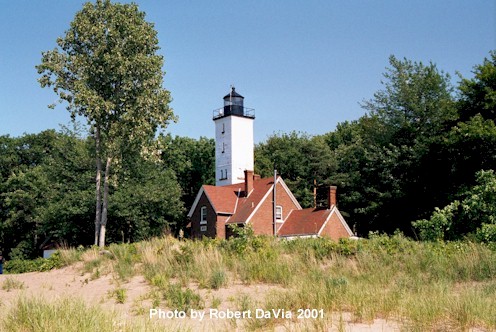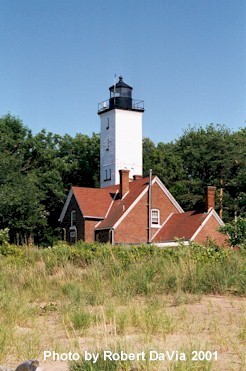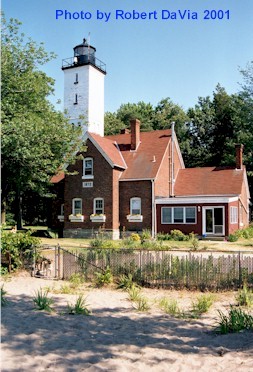Presque Isle Lighthouse

The following information was taken from the
Lighthouse Display at Presque Isle State
Park
The Loneliest Place on Earth
… is how Charles Waldo, the first keeper of the Presque Isle Lighthouse, described his seven year tenure at the station.
Waldo lived at the lighthouse with his family when, on July 12, 1873, he wrote:
“This is a new station and a light will be
exhibited for the first time tonight. There
was one visitor.”
Early United States Lighthouse Service keepers were required to “keep the
light burning” from sunset until sunrise during the shipping season, April through
November. Keepers were paid a total of $520
per year for 365 days of service.
Until a road to the mainland was built in 1927, the keepers and their families were
quite lonely, their isolation broken by the arrival of a supply tender several times each
year.


The Flashlight
A
fourth-order Fresnel lens, designed by French physicist Augustin Fresnel, was mounted at
the top of the tower. Encased in brass, a
single oil lamp projected a warning beam visible up to 13 nautical miles away. Because each light had a characteristic signal,
mariners watched for two red and four white flashes, informing them that they were indeed
seeing the Presque Isle lighthouse, or “flashlight” as it was commonly known.
Responsibility
for maintaining the light rests with the United States Coast Guard. Modern day shipboard electronics have greatly
reduced the need for lighthouses, although they remain a significant geographic point of
reference for small boats.
Construction
began in September 1872 and was completed by the following July. Initially, the tower height was 40-feet. In August of 1896, a project to increase the tower
height to 57-feet was begun to enhance the visibility of the light from the lake. The iron stops leading to the tower were
fabricated in Pittsburgh and shipped to Erie by barge.
Attached
to the tower is a ten-room residence that retains much of the original architectural
characteristics. Conveniences, such as
running water, indoor plumbing, and electricity were added in later years.
The
interior of the residence still reflects a typical 19th century French
architectural design with rounded corners and hand crafted woodwork. Most of the wood was milled from trees near the
station.
The
oil room (later the battery room) at the base of the stairway was used to store a one
night supply of oil for the lamp. Keepers
kept a night-long vigil to ensure continuous flashing of the light for the heavy lake
traffic of the 1800’s.
The Peninsula’s First Roadway
This primitive trail, some 1.5 miles long, served as a link for lighthouse children
to reach mainland schools. Wooden boards were
added to make the walk easier, bridging the wet or muddy portions that were constantly
threatened by the changes in the water levels of the lake.
Walking the trail, boating to the city, and then walking to school were a fact of
life for children until the main road opened in 1927.
Today, walkers on the trail can only speculate on the mysteries and history that
surround this unique site.
Commonwealth
of Pennsylvania
Department
of Conservation and Natural Resources
Bureau
of State Parks
About the Tower and Buildings
The Light
The Keepers
Construction History
· The tower is 57 feet high at the steel balcony, with the light 63 feet above ground level. The overall height of the tower, to the top of the ventilator ball is 70 feet.
· Constructed
of brick, five courses thick, the tower is square on the outside and round on the inside. The thickness is needed to protect the structure
from the fierce storms that occur on Lake Erie.
· Limestone
was used as the foundation for the tower and residence.
Plans originally called for the entire structure to be built of limestone,
but the design was later changed to use bricks above ground to reduce costs.
· A
winding staircase of 78 iron steps provides access to the lantern room at the top. The steps were forged in Pittsburgh and shipped by
barge on the Erie Canal system.
· The
residence consisted of ten rooms at time of construction.
The sunroom on the northwest corner was added later bringing the current
number of rooms to eleven.
· The
service room at the bottom of the tower was used by the keepers during their nightlong
vigil. It was also called either the
“oil room” or “battery room” depending on the technological era.
· For
many years, water was obtained from a hand pump located on the south side of the
residence, next to the sidewalk. The terra
cotta base of the fixture is still visible.
· The
small metal and brick building in the yard is the fuel storage building, or oil shed. Twice a year, the Lighthouse Service would supply
the station with whale oil, kerosene, diesel, and other fuels to power the light or
generators. These flammable materials were
stored in the oil shed to reduce the risk of fire in the tower and residence. Keepers would only bring one night’s supply
into the lighthouse as a precaution against fire.
· Roads
didn’t reach the lighthouse until 1927. At
first, the road passed on the lakeside of the
lighthouse, but storms continually damaged the road and washouts were common. The road was moved in 1948 to its current, more
protected location.
· A
barn, storage building and privies were also on the site but have been removed due to
their poor condition.
The Light
· The
original light was a fourth order Fresnel (the “s” is silent) lens constructed
of intricate glass prisms that concentrated the light into a band that projected toward
the horizon. Fresnel lenses were made in
France and used throughout the world. They
were the finest lenses for this type of application and displayed a bright, white light. The prisms were extremely delicate and keepers
spent much of their time caring for the lenses. Fourth
order refers to the relative size of the lens, first order is the largest and sixth order
is the smallest.
· The
light was originally fueled by whale or kerosene, using a series of lamps and wicks. The light was electrified in the 1920’s, with
a 150 watt bulb being used.
· When
first electrified, keepers would run diesel generators during the day charging a bank of
batteries. The light and residence would then
operate off the batteries throughout the night.
· The
original light displayed an alternating red and white light, with an interval of ten
seconds between the flashes. The flashes were
created by the lens revolving on a series of ball bearings, with red glass panels affixed
to the outside of the lens. The lens revolved
through the use of a clockwork mechanism with chains and weights that the keeper operated.
· The
light can be seen 16 miles into the lake.
· Locals
commonly called the light the “Flashlight”.
· In
1962 the Fresnel lens was removed and a modern aircraft-type beacon installed.
· Today’s
light is created by a 250-watt bulb inside a plastic optic lens. It displays a white light on a three-second-on,
three-second-off sequence with no rotation. The
light is fully automated and maintained by the Coast Guard; very little maintenance or
monitoring is needed. An electric light
sensor controls the light.
· Attached
to the front of the tower is a battery powered back-up light that switches on
automatically when the main light is nonfunctional. The
batteries for this light are stored on the top landing of the tower, just below the
lantern room.
The Keepers
· The first keeper, Charles Waldo, was paid $520 per year to keep the light burning every night throughout the shipping season – April to November. He was also responsible for the upkeep of the tower structure, equipment, residence, out buildings, and property. Keepers were also required to respond to shipwrecks or other emergencies.
· Early
keepers were employed by the U.S. Lighthouse Service until the Service was incorporated
into the Coast Guard in 1939.
· Ensuring
proper operation of the light required keepers to climb the tower every two to four hours
to clean the lens, check for proper function, refuel, and reset the chains. This would go on from sunset to sunrise, April to
November.
· The
station was only supplied twice a year by the Lighthouse Service. These major supply drops were mainly for fuels,
new equipment, and food staples. The keepers
at Presque Isle had to travel to Erie by land (Sidewalk Trail) and boat to get other
supplies.
· In
the early days, children at the station walked to the bay and were picked up by the
Lifesaving Service who rowed them across to Erie. In
the winter, they walked or skated across the ice to school.
· Before
the advent of cars and trucks and a road onto the peninsula, the station was very
isolated. It was often referred to as
“The Loneliest Place on Earth”.
· Many
keepers have also served the public at the Presque Isle Light Station. They were:
Charles
Waldo
July 1, 1873 – September 30, 1880
Orrin
J. McAllister
October 1, 1880 – October 8, 1880 (8 days)
George
E. Town
October 1880 – March 3, 1883
Clark
M. McCole
March 1883 – April 6, 1886
Lewis
Vannatta
April 1886 – October 1, 1891
Louis
Walrouse
October 1891 – October 6, 1892
Thomas
L. Wilkens
October 1892 – May 31, 1901
Andrew
W. Shaw
June 1901 – 1927 (Longest term as keeper)
Frank
Huntington
1927 – 1944
The
Huntington’s were the last of the true “keepers of the light” since the
lighthouse stood vacant from 1944 to 1956. After
that, various individuals and families lived in the lighthouse as residents – but not
as hired keepers. They monitored the light
for proper operation, but technology was making the job of keeper much easier.
Construction History
· Commissioned
in 1870 by the U.S. Lighthouse Service to replace the Erie Light Station (commonly called
the Land Lighthouse).
· The
Presque Isle Light Station was needed to warn mariners of the seven-mile long peninsula
(Presque Isle) jutting out into Lake Erie on an otherwise straight coastline. The light was also needed to provide mariners with
a location marker so they could confirm their location as they traveled through the lake.
· Construction
of the station began in September 1872. Building
materials were first brought to the lakeside of the project, but this proved to be too
difficult and dangerous. A scow carrying
6,000 bricks was lost early in the project causing builders to consider a new method of
getting materials to the site.
· A
crude roadway was established to connect the light station with Misery Bay on the city
side of the peninsula to allow safer access to the site.
This 1.5 mile roadway was originally just a sandy path through the swampy
interior, but was later planked to improve conditions.
In 1925, a narrow concrete strip was laid on the path. This concrete “sidewalk” is still
visible today as the park’s Sidewalk Trail. The
north-end or this sidewalk ends near the lighthouse tower.
· On
December 8, 1872, construction was suspended for winter.
In the initial three months of construction, the masonry of the residence
and that of the tower was well under way, the residence was roofed, and the tower covered.
· Construction
resumed in April 1873, and the station was ready for occupancy on July 1, 1873. The entire station cost $15,000 to construct.
· The
first keeper was Charles Waldo who brought his family to the station to live. In his log on July 12, 1873, Charles Waldo wrote: “This
is a new station and a light will be exhibited for the first time tonight – there was
one visitor.”
Return to the Pennsylvania State Page
Return to the: Alphabetical Listing or the Listing by States
